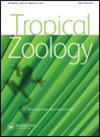Synopsis and potential geographical distribution of Cotinis (Coleoptera: Scarabaeidae: Cetoniinae: Gymnetini) in Colombia
IF 0.4
4区 生物学
Q4 ZOOLOGY
引用次数: 2
Abstract
A taxonomic synopsis and analysis of the potential distribution of the three Cotinis species found in Colombia are presented, based on the revision of 212 specimens deposited in 20 entomological collections. Based on collection information and geo-referencing locality data, the rate of record accumulation over time and observed distribution for each species were examined. Potential distribution maps were generated following biogeographic, bioclimatic, conservation, and expert criteria. Potential distribution models were made according to the amount and degree of record spatial aggregation. Cundinamarca, Tolima, Magdalena, and Sucre are the departments with the greatest number of species occurrence data. The analysis of potential distribution showed that Cotinis columbica is restricted to Andean ecosystems, while Cotinis lebasi is showing potential distribution in humid tropical forest areas in Colombia. On the other hand, the Jackknife test indicated that available data for Cotinis barthelemyi do not provide a potential distribution model better than would be expected from chance. With the increase in comprehensive taxonomic monographs, which compile high quality collection data, this type of analysis could be implemented for other groups of Scarabaeoidea in Colombia to evaluate the temporary and spatial representativeness of sampling across different scales.哥伦比亚金蝇属(鞘翅目:金龟科:金蝇科)概述及潜在地理分布
本文通过对哥伦比亚20个昆虫馆藏212个标本的订正,对在哥伦比亚发现的3种大翅虫的潜在分布进行了分类概述和分析。基于收集信息和地理参考地点数据,对每个物种的记录累积率和观测分布进行了研究。根据生物地理、生物气候、保护和专家标准生成潜在分布图。根据记录空间聚集的数量和程度,建立了潜在分布模型。Cundinamarca、Tolima、Magdalena和Sucre是物种发生数据最多的部门。潜在分布分析表明,哥伦比亚可替尼主要分布于安第斯山脉生态系统,而巴西可替尼则在哥伦比亚热带湿润林区具有潜在分布。另一方面,Jackknife检验表明,可替尼的现有数据不能提供比随机预期更好的潜在分布模型。随着高质量采集数据的综合性分类专著的增多,这种分析方法可应用于哥伦比亚其他Scarabaeoidea类群,以评估不同尺度取样的临时代表性和空间代表性。
本文章由计算机程序翻译,如有差异,请以英文原文为准。
求助全文
约1分钟内获得全文
求助全文
来源期刊

Tropical Zoology
生物-动物学
CiteScore
2.50
自引率
0.00%
发文量
1
审稿时长
>12 weeks
期刊介绍:
Tropical Zoology is an international zoological journal publishing original papers in the field of systematics, biogeography, phylogeny, ecology and conservation of all terrestrial and aquatic animal Phyla from tropical and subtropical areas.
Only papers with new information, high quality and broad interest are considered. Single species description and checklists are not normally accepted. Review papers are welcome. The journal is owned by the Istituto di Ricerca sugli Ecosistemi Terrestri of the Consiglio Nazionale delle Ricerche, Florence, Italy (CNR-IRET) who performs research into the structure and functioning of aquatic and terrestrial ecosystems, focusing in particular on anthropogenic pressure and global change. The knowledge amassed forms the scientific basis for identifying the most appropriate protective and corrective interventions, and provides support for the bodies entrusted with formulating policies for environmental protection and recovery.
 求助内容:
求助内容: 应助结果提醒方式:
应助结果提醒方式:


